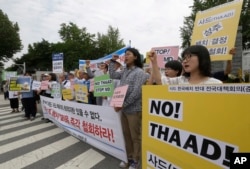Protesters pelted South Korean Prime Minister Hwang Kyo-ahn with eggs and water bottles Friday as he tried to allay the concerns of citizens living near the site where the U.S. Terminal High Altitude Area Defense (THAAD) missile defense system will be deployed.
“With regards to the THAAD radar deployment, we will fully listen to your opinion and make sure safety is secured as a priority,” Hwang said as he spoke in front of Seongju County hall on Friday.
Demonstrators responded to the prime minister’s remarks with a chorus of angry jeers and his security team held up brief cases and umbrellas to protect him from the objects being thrown by the angry crowd. He then was forced to take shelter inside the county hall.
Radiation fears
The South Korean Defense Ministry decision this week to deploy THAAD in the southeastern county of Seongju has sparked public fear that THAAD could endanger the health and safety of people living nearby, especially from exposure to radiation from the systems’ powerful radar emissions.
South Korean President Park Geun-Hye said this week the existential threat posed by North Korea’s increasing nuclear and ballistic missile capabilities has prompted the government to quickly bolster its missile defenses.
“This is because we've judged that nothing is more important than protecting the lives and the safety of our people under the situation that the North's nuclear and missile threats have become a reality," said Park.
However many Seongju residents are angry that the THAAD deployment decision was made without their input and without independent health, environmental and economic assessments.
“Our Seongju residents, 50,000 of them, are outraged that the decision was made unilaterally without prior consultation or agreement," said Seongju County Administrative Chief Kim Hang-Gon at a rally in Seoul on Wednesday.
THAAD radar
THAAD uses high-resolution radar designed to detect and track ballistic missile threats at long distances and high altitudes. The system’s radar and infrared seeking technology are used to program six mobile launchers and 48 interceptor missiles.
THAAD opponents express concern that exposure to the electromagnetic radiation from the system’s radar could cause serious harm to nearby residents and could contaminate agricultural products.
Seoul’s Defense Ministry on Thursday tried to answer these concerns by taking a group of reporters to a previously undisclosed Patriot missile defense site in the Chungcheong region south of Seoul.
The Patriot site has been in place since 2012 and uses a similar radar system to THAAD. Officials say residents living nearby have developed no health problems from the Patriot radar emissions.
Military officials measured the electromagnetic waves being emitted by the Patriot radar during a demonstration for the gathered journalists. From a distance of 30 meters away from the radar system, the output peaked at 0.2658 watts per square meter, which is well below the 10 watts per square meter safety threshold.
Officials said local law adheres to the 10 watts per square meter limit set by the International Commission on Non-Ionizing Radiation Protection’s guidelines. Exposure to waves exceeding this amount would lead to body-heat stress and excessive local tissue heating.
Based on U.S. assessment, the South Korean Defense Ministry says it has set a 100 meter radius safety zone around the radar site.
The military assured the residents the THAAD battery will be placed 1.5 kilometers away from the nearest population center and will not cause any adverse effects on the local community.
The prime minister also apologized to Seongju residents for making the THAAD deployment decision “with prior notice.”
Protesters in Seongju discount the government assurances and remain opposed to THAAD being deployed near their communities.
However a survey conducted this week by Gallup Korea found that 50 percent of respondents were in favor of the government’s decision to deploy THAAD.
Youmi Kim in Seoul contributed to this report.









